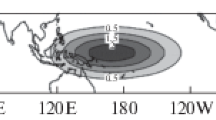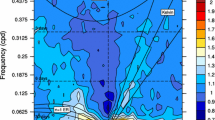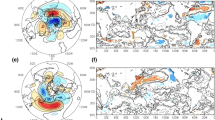Abstract
The Madden-Julian oscillation (MJO) simulated by the Canadian Climate Centre general circulation model (CCC GCM) is identified by a principal oscillation pattern (POP) analysis and compared with that observed in the real atmosphere. The results are based upon two integrations of the CCC GCM, one with a parameterization of penetrative cumulus convection (EXP1) and the other with a moist convective adjustment scheme (EXP2). The signal of MJO can be detected in both integrations as the first POP of the 200 hPa velocity potential along the equator. The disturbances show a distinctive wave number one structure with the strongest local amplitude found in the longitudes corresponding to the region of the Asian monsoon. The phase speed of the eastward wave propagation is higher in the eastern Pacific and lower in the monsoon region where the convective activities are strongest. These features are in good agreement with the observations. The energy spectrum of the velocity potential peaks at the frequency corresponding to a period of about 38 days for EXP1, which is somewhat shorter compared to the observed periods of 40–50 days. On the other hand, two spectral peaks can be clearly identified for EXP2, one with a period of 24 days and the other with a much longer period, somewhere near 112 days. Both peaks appear statistically significant at 95% level. Long term data of the observed atmosphere show little indication of such spectral separation. The horizontal patterns identified by the POP analysis resemble to some extent the baroclinic response of tropical flow to a heat source travelling with the speed of MJO. At the upper level, Rossby wave energy propagates westward with winds generally following the height contours, whereas Kelvin wave energy propagates to the east from the heat source with strong cross-contour flow near the equator. At the lower level, the patterns are essentially reversed. The model-generated precipitation and diabatic heating are examined by compositing against the moving MJO. It is found in EXP2 that the composite heating distribution is coherent with the flow pattern only in a certain sector of the equator, depending on whether the fast or slow mode is used to determine the reference point. The composite vertical heating profile of a slower mode tends to have a maximum found at a lower level. The sensitivity of simulated MJO to the cumulus convection scheme in the model is discussed.
Similar content being viewed by others
References
Arakawa A, Schubert WH (1974) Interaction of a cumulus cloud ensemble with the large-scale environment. Part 1. J Atmos S631:674–701
Boer GJ, McFarlane NA, Lazare M (1992) Greenhouse gasinduced climate change simulated with the CCC second-generation general circulation model. J Clim 5:1045–1077
Chang C-P (1977) Viscous internal gravity waves and low-frequency oscillations in the tropics. J Atmos Sci 34:901–910
Chang C-P, Lim H (1988) Kelvin wave-CISK: a possible mechanism for the 30–50-day oscillations? J Atmos Sci 45:1709–1720
Chao WC (1987) On the origin of the tropical intraseasonal oscillation. J Atmos Sci 44:1940–1949
Emanuel KA (1987) An air-sea interaction model of intraseasonal oscillations in the tropics. J Atmos Sci 44:2324–2340
Gill AE (1980) Some simple solutions for heat-induced tropical circulation. Q J R Meteorol Soc 106:447–462
Hasselmann K (1988) PIPs and POPS: the reduction of complex dynamical systems using principal interaction and oscillation patterns. J Geophys Res 93:11015–11021
Hayashi Y (1970) A theory of large-scale tropical waves generated by condensational heat and accelerating the zonal wind. J Meteorol Soc Japan 48:140–160
Hayashi Y, Golder DG (1993) Tropical 40–50- and 25–30-day oscillations appearing in realistic and idealized GFDL climate models and the ECMWF dataset. J Atmos Sci 50:464–494
Hayashi Y-Y, Sumi A (1986) The 20–40-day oscillation simulated in an “aqua-planet” model. J Meteorol Soc Japan 64:431–466
Lau N-C, Lau K-M (1986) The structure and propagation of intraseasonal oscillations appearing in a GFDL GCM. J Atmos Sci 43:2023–2047
Lau K-M, Peng L (1987) Origin of low frequency (intraseasonal) oscillations in the tropical atmosphere. Part 1: basic theory. J Atmos Sci 44:950–972
Lau N-C, Held IM, Neelin JD (1988) The Madden-Julian oscillation in an idealized general circulation model. J Atmos Sci 45:3810–3832
Lindzen RS (1974) Wave-CISK in the tropics. J Atmos Sci 31:156–179
Madden RA, Julian PR (1972) Description of global-scale circulation cells in the tropics with a 40–50 day period. J Atmos Sci 29:1109–1123
Manabe S, Smagorinsky J, Strickler RF (1965) Simulated climatology of a general circulation model with a hydrologic cycle. Mon Weather Rev 93:769–798
McFarlane NA, Boer GJ, Blanchet J-P, Larare M (1992) The Canadian Climate Centre second generation general circulation model and its equilibrium climate. J Clim 5:1013–1044
Neelin JD, Held IM, Cook KH (1987) Evaporation-wind feedback and low-frequency variability in the tropical atmosphere. J Atmos Sci 44:2341–2348
Numaguti A, Hayashi Y-Y (1991) Behavior of cumulus activity and the structures of circulations in an “aqua planet” model. J Meteorol Soc Japan 69:541–561
Storch H von, Xu J (1990) Principal oscillation pattern analysis of the 30- to 60-day oscillation in the tropical troposphere. Part 1: definition of an index and its prediction. Clim Dyn 4:175–190
Storch H von, Bruns T, Fischer-Bruns I, Hasselmann K (1988) Principal oscillation pattern analysis of the 30- to 60-day oscillation in a general circulation model equatorial troposphere. J Geophys Res 93:11022–11036
Storch H von, Bürger G, Schnur R, Storch J-S von (1995) Principal oscillation patterns: A review. J Clim 8:377–400
Swinbank RT, Palmer N, Davey MK (1988) Numerical simulations of the Madden and Julian oscillations. J Atmos Sci 45:774–788
Takahashi M (1987) A theory of the slow phase speed of the intraseasonal oscillation using the wave-CISK. J Meteorol Soc Japan 65:43–49
Wang B (1988) Dynamics of tropical low-frequency waves. An analysis of the moist Kelvin waves. J Atmos Sci 45:2051–2065
Zhang GJ (1994) Effects of cumulus convection on the simulated monsoon circulation in a general circulation model. Mon Weather Rev 122:2022–2038
Zhang GJ, McFarlane NA (1995) Parameterization of cumulus convection in the Canadian Climate Centre general circulation model. Atmos Ocean 33 (in press)
Author information
Authors and Affiliations
Rights and permissions
About this article
Cite this article
Sheng, J. The Madden-Julian oscillation in the Canadian Climate Centre general circulation model. Climate Dynamics 12, 125–140 (1995). https://doi.org/10.1007/BF00223725
Received:
Accepted:
Issue Date:
DOI: https://doi.org/10.1007/BF00223725




